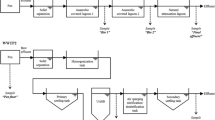Abstract
The microflora of a self-heating aerobic thermophilic sequencing batch reactor (AT-SBR) treating swine waste was investigated by a combination of culture and culture-independent techniques. The temperature increased quickly in the first hours of the treatment cycles and values up to 72°C were reached. Denaturing gradient gel electrophoresis of the PCR-amplified V3 region of 16S rDNA (PCR-DGGE) revealed important changes in the bacterial community during 3-day cycles. A clone library was constructed with the near-full-length 16S rDNA amplified from a mixed-liquor sample taken at 60°C. Among the 78 non-chimeric clones analysed, 20 species (here defined as clones showing more than 97% sequence homology) were found. In contrast to other culture-independent bacterial analyses of aerobic thermophilic wastewater treatments, species belonging to the Bacilli class were dominant (64%) with Bacillus thermocloacae being the most abundant species (38%). The other Bacilli could not be assigned to a known species. Schineria larvae was the second most abundant species (14%) in the clone library. Four species were also found among the 19 strains isolated, cultivated and identified from samples taken at 40°C and 60°C. Ten isolates showed high 16S rDNA sequence homology with the dominant bacterium of a composting process that had not been previously isolated.




Similar content being viewed by others
References
APHA (1998) Standard methods for the examination of water and wastewater, 20th edn. American Public Health Association, Washington, D.C.
Beaudet R, Gagnon C, Bisaillon JG, Ishaque M (1990) Microbiological aspects of aerobic thermophilic treatment of swine waste. Appl Environ Microbiol 56:971–976
Beaulieu M, Bécaert V, Deschênes L, Villemur R (2000) Evolution of bacterial diversity during enrichment of PCP-degrading activated soils. Microb Ecol 40:345–355
Bergey DH, Holt JG, Krieg NR (1989) Bergey’s manual of systematic bacteriology, 1st edn. Williams & Wilkins, Baltimore
Dees PM, Ghiorse WC (2001) Microbial diversity in hot synthetic compost as revealed by PCR-amplified rRNA sequences from cultivated isolates and extracted DNA. FEMS Microbiol Ecol 35:207–216
Demharter W, Hensel R (1989) Bacillus thermocloaceae sp. nov., a new thermophilic species from sewage sludge. Syst Appl Microbiol 11:272–276
Edwards U, Rogall T, Blöcker H, Emde M, Böttger EC (1989) Isolation and direct complete nucleotide determination of entire genes. Characterization of a gene coding for 16S ribosomal RNA. Nucleic Acids Res 17:7843–7853
Garrity GM, Holt JG (2001) The road map to the manual. In: Boone DR, Castenholz RW (eds) Bergey’s manual of systematic bacteriology, vol 1. Springer, New York Berlin Heidelberg, pp 119–166
Hensel R, Demharter W, Hilpert R (1989) The microflora involved in aerobic-thermophilic sludge stabilization. Syst Appl Microbiol 11:312–319
Ishii K, Takii S (2003) Comparison of microbial communities in four different composting processes as evaluated by denaturing gradient gel electrophoresis analysis. J Appl Microbiol 95:109–119
Juteau P, Tremblay D, Ould-Moulaye CB, Bisaillon JG, Beaudet R (2004) Swine waste treatment by self-heating aerobic thermophilic bioreactors. Water Res 38:539–546
Kurisu F, Satoh H, Mino T, Matsuo T (2002) Microbial community analysis of thermophilic contact oxidation process by using ribosomal RNA approaches and the quinone profile method. Water Res 36:429–438
LaPara TM, Nakatsu CH, Pantea L, Alleman JE (2000) Phylogenetic analysis of bacterial communities in mesophilic and thermophilic bioreactors treating pharmaceutical wastewater. Appl Environ Microbiol 66:3951–3959
Muyzer G, de Waal EC, Uitterlinden AG (1993) Profiling of complex microbial populations by denaturing gradient gel electrophoresis analysis of polymerase chain reaction-amplified genes coding for 16S rRNA. Appl Environ Microbiol 59:695–700
Pedro MS, Haruta S, Nakamura K, Hazaka M, Ishii M, Igarashi Y (2003) Isolation and characterization of predominant microorganisms during decomposition of waste materials in a field-scale composter. J Biosci Bioeng 95:368–373
Sonnleitner B, Fiechter A (1983) Bacterial diversity in thermophilic aerobic sewage sludge. II. Types of organisms and their capacities. Eur J Appl Microbiol Biotechnol 18:174–180
Stackebrandt E, Goebel BM (1994) Taxonomic note: a place for DNA-DNA reassociation and 16S rRNA sequence analysis in the present species definition in bacteriology. Int J Syst Bacteriol 44:846–849
Strom PF (1985) Identification of thermophilic bacteria in solid-waste composting. Appl Environ Microbiol 50:906–913
Tiirola MA, Suvilampi JE, Kulomaa MS, Rintala JA (2003) Microbial diversity in a thermophilic aerobic biofilm process: analysis by length heterogeneity PCR (LH-PCR). Water Res 37:2259–2268
Tóth E, Kovács G, Schumann P, Kovács AL, Steiner U, Halbritter A, Márialigeti K (2001) Schineria larvae gen. nov., sp. nov., isolated from the 1st and 2nd larval stages of Wohlfahrtia magnifica (Diptera: Sarcophagidae). Int J Syst Evol Microbiol 51:401–407
USEPA (1990) Autothermal thermophilic aerobic digestion of municipal wastewater sludge. Environmental Protection Agency, Washington, D.C.
Vallaeys T, Topp E, Muyzer G, Macheret V, Laguerre G, Rigaud A, Soulas G (1997) Evaluation of denaturing gradient gel electrophoresis in the detection of 16S rDNA sequence variation in rhizobia and methanotrophs. FEMS Microbiol Ecol 24:279–285
Acknowledgements
This work was supported by the Fonds pour la Formation de Chercheurs et l’Aide à la Recherche (FCAR) and by the Institut de Recherche et Développement en Agroenvironnement (IRDA) via a grant (2000-IR-70894) under the “Action Concertée FCAR-IRDA” program. We thank Louis Racine for providing outstanding technical assistance. We also thank Guy McSween and Dr. François Shareck (INRS - Institut Armand-Frappier) for having kindly provided some of the strains used as markers in DGGE analyses.
Author information
Authors and Affiliations
Corresponding author
Additional information
An erratum to this article can be found at http://dx.doi.org/10.1007/s00253-005-1925-2
Rights and permissions
About this article
Cite this article
Juteau, P., Tremblay, D., Villemur, R. et al. Analysis of the bacterial community inhabiting an aerobic thermophilic sequencing batch reactor (AT-SBR) treating swine waste. Appl Microbiol Biotechnol 66, 115–122 (2004). https://doi.org/10.1007/s00253-004-1692-5
Received:
Revised:
Accepted:
Published:
Issue Date:
DOI: https://doi.org/10.1007/s00253-004-1692-5




